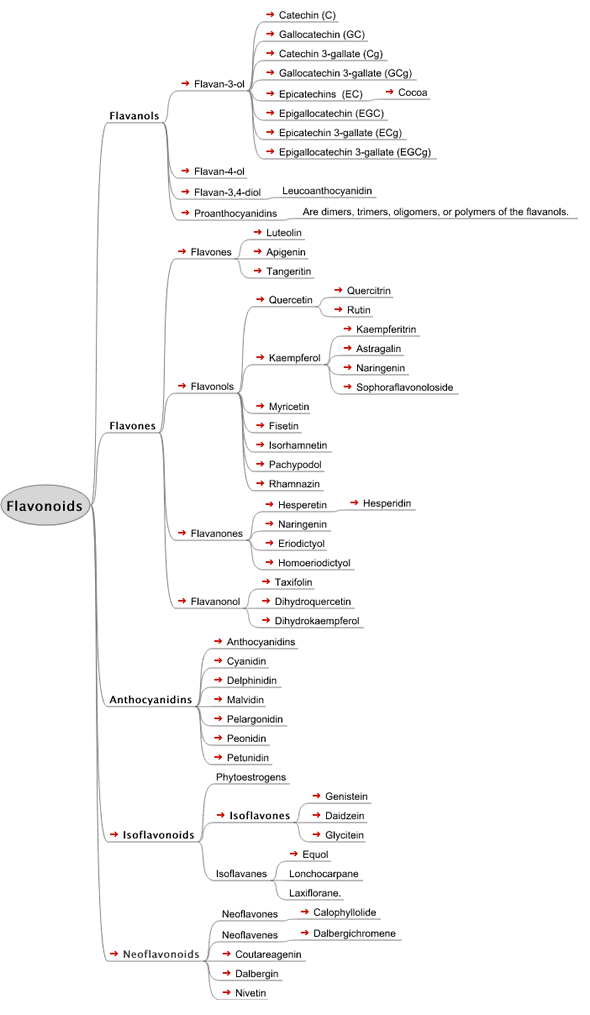There have been many news stories over the years about chocolate and whether it is good or bad for you. The stories often comment on a chemical constituent of chocolate: flavonoids. But what are flavonoids? Does chocolate even contain them? And why should we care if it does?
Flavonoids are antioxidants. They protect cells by fighting off reactive oxygen species which can damage cells. Other recognized antioxidants are vitamin C, vitamin E, selenium and carotenoids.
More specifically, flavonoids are polyphenolic antioxidants that act by removing free radicals and chelating metals.
They tend to have sugars bound at the carbon 3 position; but as you can see from Figure 1 there are many different types of flavonoid.

Figure 1: Classification of flavonoids
The anti-oxidising nature of the flavonoid depends upon its molecular structure. For example, the position of the hydroxyl groups and other molecular features determine how the flavonoid reacts with other molecules, such as free radicals.
Does chocolate contain flavonoids?
Flavonoids are known to be found in fruits, vegetables and certain drinks, such as tea; however, they are also found in chocolate.
In fact, dark chocolate contains high levels of flavonoids. A study published in The Lancet showed that chocolate contained four times as much catechin, a type of flavonoid, as tea.
Why should we care if chocolate contains flavonoids?
Flavonoids have demonstrated very interesting properties, such as anti-inflammatory and antiallergic effects. Some types of flavonoid have also been shown to inhibit carcinogen-induced tumors in rats and mice. Thus flavonoids obviously have very noteworthy properties.
But what type of benefits could we potentially gain from the types of flavonoids contained in chocolate?
One study reported in the Daily Express a few years ago stated that eating chocolate could help prevent heart attacks. The NHS, however, examined the study, to which they referred, and found that the research did not actually support the claim that they were making. This is because, the study was not directly assessing the relationship between chocolate and heart attacks
Instead the research actually demonstrated a correlation between people that ate chocolate and low levels of C-reactive protein (CRP) in the blood.
Although high CRP levels are thought to increase your chances of developing coronary heart disease (CHD); the research was not aimed at finding a link between eating chocolate and developing heart disease. Thus the researchers were, in fact, only speculating on cardiovascular risk based on chocolate consumption.
A more recent study, by The National Heart, Lung, and Blood Institute (NHLBI), has studied this link and has published that chocolate consumption is inversely associated with CHD.
The researchers found that, “in the fully adjusted model, consumption of 5+/week was associated with 57% lower prevalent CHD compared with subjects who did not consume chocolate”.
In addition, they found that consumption of non-chocolate candy did not have this effect. Moreover, they suggested that non-chocolate candy consumption showed an increased association with CHD compared with no consumption.
Yet again though, there were limitations with the study. One problem was that the data in the study was self-reported. This means there are reliability issues. For example, people may exaggerate or underestimate their chocolate intake.
Another, perhaps more serious, limitation is that the researchers could not “completely exclude residual confounding or confounding by indication as alternative explanation for observed findings.” Thus, the link between chocolate consumption and risk of CHD may not be causal, but, in fact, may be coincidental.
Essentially, despite some studies showing an association between intake of flavonoid-containing food, such as chocolate, and cardiovascular disease; the evidence, according to the Linus Pauling Institute, for flavonoids themselves being cardioprotective is limited.
Ok so the evidence between eating chocolate and reduced CHD risk is limited, but what about the cancer-reducing potential you may ask?
Well, despite various studies showing flavonoids inhibiting the development of chemically-induced cancers in some animals, the Linus Pauling Institute also claims that there is little evidence that high consumption of flavonoids reduces human cancer risk.
The downsides of chocolate
So it appears the evidence for the benefits of chocolate, due to it containing flavonoids, is inconclusive. One thing that is known though, is the downside of chocolate!
Chocolate is high in saturated and monounsaturated fats. It also often contains a lot of sugar. This means that it is very energy dense. More specifically, it contains approximately 2,200kJ per 100g. And so obviously eating high quantities of it is going to be bad for your health!
Chocolate has also been linked to migraines. Some people say that chocolate can trigger their migraines; however, for most sufferers it tends to be only one of many contributing factors.
The reason chocolate may be linked to migraines is again due to its sugar content. For eating lots of chocolate causes your blood sugar levels to rise quickly. If you do this after not eating for a significant period of time, (so that your blood sugar levels are initially very low), then your blood sugar levels move from a trough to a peak: such ‘peaks and troughs’ have been known to cause migraine attacks.